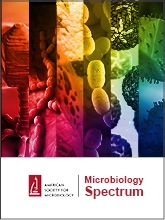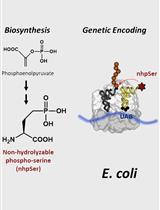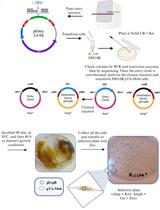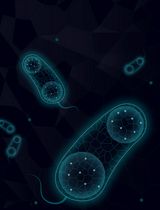- EN - English
- CN - 中文
Genome-assisted Identification, Purification, and Characterization of Bacteriocins
细菌素的基因组辅助鉴定、纯化和表征
(*contributed equally to this work) 发布: 2022年07月20日第12卷第14期 DOI: 10.21769/BioProtoc.4477 浏览次数: 3797
评审: Alba BlesaValentine V TrotterXuhui Zheng
Abstract
Bacteriocins are antimicrobial peptides with activity against antibiotic resistant bacterial pathogens. Here, we describe a set of methods aimed at purifying, identifying, and characterizing new bacteriocins. The purification consists of ammonium sulphate precipitation, cation-exchange chromatography, and reversed-phase chromatography. The yield of the bacteriocin is quantified by bacteriocin antimicrobial activity in a microtiter plate assay after each purification step. The mass of the purified bacteriocin is assessed by MALDI TOF MS analysis of the active fractions after reversed-phase chromatography. The mass is compared with the theoretical mass based on genetic information from the whole genome sequencing of the bacteriocin producer strain. Physicochemical characterization is performed by assessing antimicrobial activity following heat and protease treatments. Fluorescent techniques are used to examine the capacity of the bacteriocin to disrupt membrane integrity. Herein a set of protocols for purification and characterization of the bacteriocin nisin Z is used as a typical example in this paper.
Keywords: Bacteriocin (细菌素)Background
Antibiotics used to treat bacterial infections are becoming increasingly less efficacious due to the emergence of antibiotic-resistant pathogens (Högberg et al., 2010). In addition, such pathogens are often resistant to two or more antibiotics. As a consequence, first line therapies often involve the administration of either multiple or broad-spectrum antibiotics (Hagihara et al., 2012; Khameneh et al., 2016; Frieri et al., 2017). The overuse of antibiotics is thought to be the primary selection pressure driving the dissemination of resistance (World Health Organization, 2018). In addition, broad-spectrum treatments are known to cause long lasting alterations to the healthy gut microbiota, which is likely to have unforeseen health consequences (Willing et al., 2011). For these reasons, there is a need for alternative antimicrobials, such as bacteriocins, that could be used therapeutically.
Bacteriocins are ribosomally synthesized antimicrobial peptides produced by bacteria to kill or inhibit other closely related bacteria for nutrients and/or niche competition (Eijsink et al., 2002). Bacteriocins comprise a very diverse group of peptides, from extensively post-translationally modified molecules (class I) to small unmodified peptides (class II) (Alvarez-Sieiro et al., 2016; Acedo et al., 2018). Most bacteriocins produced by Gram-positive bacteria are cationic (pI > 7) and hydrophobic/amphiphilic peptides (Diep and Nes, 2002). They are often of small size ranging from 40 to 70 amino acids, heat-stable, and do not lose activity after storage in organic solvents (2-propanol, acetonitrile, etc.). Most bacteriocins are protease-sensitive (especially unmodified peptides) and have narrow inhibitory spectra, targeting species or genera closely related to the producer (Nissen-Meyer and Nes, 1997), but some have wide inhibitory spectra (Field et al., 2015; Ovchinnikov et al., 2016). Unlike most antibiotics, bacteriocins normally exploit membrane proteins as receptors and disrupt the membrane integrity of sensitive cells upon binding, causing leakage of intracellular solutes and eventually cell death (Nes et al., 2007). Thus, due to different modes of action, bacteriocins are most often equally active against both antibiotic-sensitive pathogens and their antibiotic-resistant counterparts. Bacteriocins have many desirable properties for clinical use, such as high potency, low toxicity, specific inhibition spectrum, and the potential probiotic use of producer organisms (Cotter et al., 2013). However, bacteriocins have not been used in human clinical settings so far. There are a few challenges to the clinical use of bacteriocins, such as their sensitivity towards proteases and low solubility under physiological conditions. Another major factor is likely the insufficient investment spent on the discovery and characterization of new bacteriocins to find candidates more suitable for medical applications.
Here, we describe a set of methods for bacteriocin purification, identification, and characterization. The methods have been used to characterize several bacteriocins in our laboratory (Holo et al., 1991; Ovchinnikov et al., 2016; Desiderato et al., 2021; Goldbeck et al., 2021; Oftedal et al., 2021; Weixler et al., 2022). We believe that this scheme is a good starting point for most bacteriocins and could easily be optimized for special cases, such as multi-peptide bacteriocins, circular bacteriocins, or bacteriocins with relatively low isoelectric points.
Materials and Reagents
0.2 µm syringe filter, Filtropur S, PES (Sarstedt, catalog number: 83.1826.001)
Eppendorf Safe-Lock microcentrifuge tubes (Sigma-Aldrich, catalog number: EP0030123611)
1.5 mL microcentrifuge tubes (Eppendorf Safe-Lock, catalog number: EP0030123611)
Micro test plate, 96-well, transparent (Sarstedt, catalog number: 82.1581.001)
NalgeneTM PPCO Centrifuge Bottles (Thermo Scientific, catalog number: 3141-0250PK)
Glass laboratory bottles (VWR, catalog numbers: 215-1514, 215-1515, 215-1517, 215-1518)
15 mL reaction tubes (Sarstedt, catalog number 62.554.002)
Black microtiter plates (Sarstedt, catalog number: 82.1581.120)
D-(+)-Glucose monohydrate (Sigma-Aldrich, catalog number: 49159)
M17 broth (Oxoid, catalog number: CM0817)
Bacteriological agar (Oxoid, catalog number: LP0011T)
Ammonium sulphate (Sigma-Aldrich, catalog number: 7783-20-2)
Na2HPO4·2H2O (Sigma-Aldrich, catalog number: 71643)
NaH2PO4 (Sigma-Aldrich, catalog number: S0751)
NaCl (Sigma-Aldrich, catalog number: S7653).
Proteinase K (Sigma-Aldrich, catalog number: P2308)
2-Propanol ≥99.0%, GPR RECTAPUR® (VWR Chemicals, catalog number: 20839.366)
Hydrochloric acid (Sigma-Aldrich, catalog number: 320331)
Trifluoroacetic acid, suitable for HPLC, ≥99.0% (Sigma-Aldrich, catalog number: 302031)
Acetonitrile, LiChrosolv® Reag. Ph Eur. (Merck Millipore, catalog number: 1000302500)
α-cyano-4-hydroxycinnamic acid (Bruker, catalog number: 8201344)
Bruker MTP 384 Target Plate Ground Steel BC (Bruker, catalog number: 8280784)
Peptide Calibration Standard II (Bruker LabScape Daltonics, catalog number: 8222570)
Propidium Iodide (Fisher Scientific, Invitrogen, catalog number: P1304MP)
Brain Heart Infusion Broth (Dehydrated) (Thermo Scientific, Oxoid, catalog number: CM1135B)
GenEluteTM Bacterial Genomic DNA Kits (Sigma-Aldrich, catalog number: NA2120-1KT)
Chloramphenicol (Sigma-Aldrich, catalog number: C0378)
KH2PO4 (Sigma-Aldrich, catalog number: 795488)
MgSO4 (Sigma-Aldrich, catalog number: M7506)
(NH4)2SO4 (Sigma-Aldrich, catalog number: A4418)
Nisin (Sigma-Aldrich, catalog number: N5764-5G)
Micrococcin P1 (Cayman Chemical, catalog number: 17093)
MOPS (3-Morpholino-propanesulfonic acid) (Sigma-Aldrich, catalog number: 69947)
Solution A (see Recipes)
Solution B (see Recipes)
Sodium phosphate wash buffer (see Recipes)
PBS (Phosphate-buffered saline) (see Recipes)
HCCA matrix solution (see Recipes)
Listeria minimal buffer (LMB) (see Recipes)
Equipment
ÄKTA purifier w/ Box-900, pH/C-900, UV-900, P-900, Frac-900 (Pharmacia Biotech)
HiPrep SP XL 16/10 (GE Healthcare, catalog number: 28936540)
RESOURCE RPC 1 mL (Cytiva, catalog number: 17118101)
TS-100 Thermo-Shaker (Biosan, catalog number: BS-010120-AAI)
-86°C ULT Chest Freezer (Thermo Scientific, model: 8708)
Incubator (Termaks, model: KBP6395LL)
Microfuge 16 (Beckman Coulter)
FinnpipetteTM F2 GLP Kits (Thermo Scientific, catalog number: 4700880)
FinnpipetteTM F2 Multichannel Pipette (Thermo Scientific, catalog number: 4662030)
pH meter (Mettler Toledo® F20)
SPECTROstarNano (BMG LABTECH, Germany)
High-speed centrifuge Avanti J-26 XP w/ JA-14 rotor (Beckman Coulter)
Merck Milli-Q Integral 10 (Merck Millipore)
Ultrasonic bath (VWR, model: USC100T)
NanoDrop 2000/2000c (Thermo Scientific, catalog number: ND-2000C)
Hidex Sense Multi-Mode Microplate Reader
Rotary shaking incubator (I26, New Brunswick Scientific)
Infinite M200 fluorescence microplate reader (Tecan)
IKA RCT magnetic stirrer (IKA, catalog number: 0003810000)
Software
Unicorn 5.11 to support ÄKTA (Cytiva, https://www.cytivalifesciences.com/en/us/shop/unicorn-5-11-p-03388)
Procedure
文章信息
版权信息
© 2022 The Authors; exclusive licensee Bio-protocol LLC.
如何引用
Ovchinnikov, K. V., Oftedal, T. F., Reich, S. J., Bar, N. S., Holo, H., Skaugen, M., Riedel, C. U. and Diep, D. B. (2022). Genome-assisted Identification, Purification, and Characterization of Bacteriocins. Bio-protocol 12(14): e4477. DOI: 10.21769/BioProtoc.4477.
分类
微生物学 > 抗微生物试验
生物化学 > 蛋白质
生物科学 > 微生物学
您对这篇实验方法有问题吗?
在此处发布您的问题,我们将邀请本文作者来回答。同时,我们会将您的问题发布到Bio-protocol Exchange,以便寻求社区成员的帮助。
Share
Bluesky
X
Copy link













